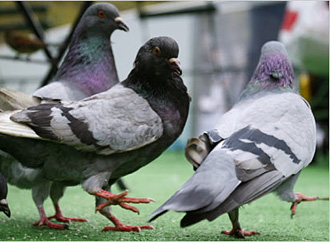
|  |  |  Editorials | Environmental | July 2008 Editorials | Environmental | July 2008  
Declaring War on Pigeons
 Daniela Estrada - Tierramérica Daniela Estrada - Tierramérica
go to original


| | Urban life contributes to pigeon overpopulation. | | |
Santiago - The cities of the world are ideal habitat for the proliferation of the pigeon, or rock dove, a picturesque species that actually poses health and environmental risks.

Experts recommend not feeding them, refitting buildings that provide roosting sites, and controlling garbage in order to keep the pigeon population in check.

Chile declared pigeons "prejudicial or harmful" in 2004 and authorised hunting of these birds.

"The doves (Columba livia) cause permanent damage," veterinarian Pedro Cattan, assistant director of the University of Chile's pest research and management centre, told Tierramérica.

They carry pathogenic agents that can be transmitted to other birds or to humans, and their excrement, rich in uric acid, "corrodes homes, buildings, monuments and machinery," he said.

Pigeons can spread bacteria like salmonella, which causes gastrointestinal illness; Chlamydophila, which causes severe respiratory distress and fever; yeasts like Cryptococcus neoformans, which can affect the meninges and the central nervous system; and parasites like the red mite (Dermanyssus gallinae), which is linked to dermatological problems.

In addition to leaving unsightly messes, the bird droppings damage air-conditioning systems and can ruin products stored in warehouses, causing economic losses.

Originating in Europe, Asia and North Africa, the rock dove was introduced to the Americas as a domesticated bird in the 16th century, but soon began to reproduce in the wild, experts from the Chilean government's Agriculture and Livestock Service (SAG), told Tierramérica.

Adults measure 34 to 38 centimetres and can weigh between 330 and 450 grams. The feathers on the head, tail and wings are usually grey, with metallic green and violet glints around the neck.

The main reasons for the abundance of pigeons are their longevity (they live 15 to 20 years), the lack of natural predators, and their prolific breeding. They live in pairs and can produce as many as 12 fledglings per year.

But the uncontrolled increase of this species in cities goes hand in hand with urban conditions: buildings with many crevices and niches where they can make their nests, and an abundance of food waste, as well as the popular custom of feeding them.

Pigeons eat seeds and fruit, but they also eat whatever human food they can find, said Cattan.

The number of pigeons in Chile is unknown, but their proliferation in cities led to the declaration that they are harmful to health and the environment. The Law on Hunting authorises that they can be taken in unlimited numbers and their nests can be destroyed, in any season and anywhere in the country. But the use of chemicals is banned because they can have harmful effects on other species.

"Their mere elimination does not solve the problem. On the contrary, it has been shown as a cause behind the increase in their population in the medium term," because the possibility for survival increases as there is less competition for resources, said Pedro Varas, a veterinarian with the Santiago regional health ministry.

As such, in addition to authorised hunting, he recommends repellants and structural modifications.

On Jun. 23, the "El Rancagüino" newspaper wrote that "hundreds of pigeons" sought refuge on the roofs of the municipality of Manso de Velasco, in Rancagua, capital of the central region of O'Higgins.

"In apartment number 42 in block 4, a covey of pigeons has installed itself, taking advantage of the absence of the residents. There is even a nest with eggs in the bathroom, while the rest of the rooms are covered by the birds' excrement," stated the newspaper.

Tierramérica attempted to contact officials from the Rancagua health centre, but did not obtain a response.

"In Chile there are few health studies of free roaming pigeons," admits SAG. In 1999, experts examined 100 birds in Santiago, and found that three percent had salmonella.

Researchers at the University of Concepción studied 100 pigeons in the city of Chillán, in the southern region of Bío-Bío, and found chlamydiosis (11 percent), staphylococcosis (eight percent), salmonellosis (four percent) and aspergillosis (one percent). The conclusions were published in 2007.

Miguel Vergara, owner of the company Ave Soluciones, has spent six years installing invisible mesh, steel wire fences or barbed wire systems on rooftops, eaves, antennas and other places where pigeons might try to land, build nests or leave droppings.

"About 60 percent of my clients are private homes," he told Tierramérica.

Vergara said he knew of two people who had died from infections transmitted by pigeons. But, according to Varas, of the Santiago regional health ministry, "there are no records of transmittable diseases in humans attributable to contact with pigeons."

Three years ago, some 100 pigeons invaded the terrace of the Elkika Ilmenau restaurant in Santiago, upsetting the diners, who were primarily European tourists. In the end, they were controlled by installing lines of wire across the roof, owner Mauricio Acuña told Tierramérica.

"We didn't know about the diseases," he said.

Daniela Estrada is an IPS correspondent. Originally published by Latin American newspapers that are part of the Tierramérica network. Tierramérica is a specialised news service produced by IPS with the backing of the United Nations Development Programme, United Nations Environment Programme and the World Bank. |

 |
|  |



